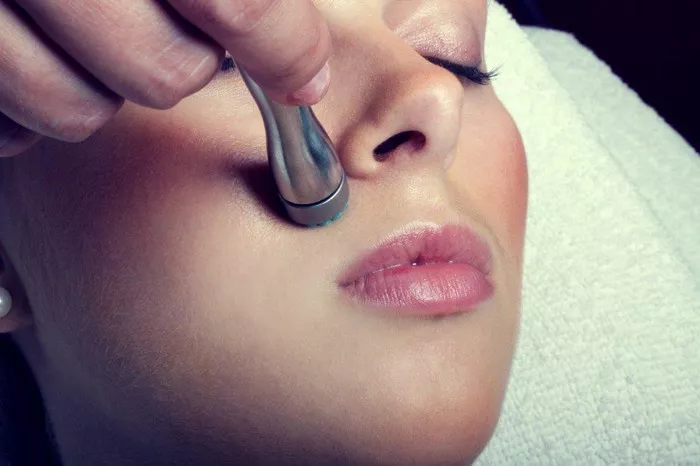Hyperpigmentation is a common skin condition that occurs when the skin produces too much melanin, the pigment that gives skin its color. This can result in dark spots, patches, or uneven skin tone. While there are many treatments available for hyperpigmentation, one option that has gained popularity in recent years is microdermabrasion. In this article, we will explore the benefits of microdermabrasion for hyperpigmentation, how it works, and what you need to know before undergoing the treatment.
What is Microdermabrasion?
Microdermabrasion is a cosmetic procedure that involves removing the outermost layer of dead skin cells to reveal smoother, younger-looking skin underneath. The treatment is typically performed using a handheld device that sprays tiny crystals onto the skin and then vacuums them away, along with the dead skin cells. Microdermabrasion can be performed on the face, neck, chest, hands, and other areas of the body.
The Benefits of Microdermabrasion for Hyperpigmentation
Microdermabrasion can be an effective treatment for hyperpigmentation, as it can help to remove the outer layer of skin where the excess melanin is located. Here are some of the benefits of microdermabrasion for hyperpigmentation:
Exfoliation – Microdermabrasion is a gentle and non-invasive way to exfoliate the skin and remove the outermost layer of dead skin cells. This can help to reduce the appearance of hyperpigmentation and improve the overall texture and tone of the skin.
Stimulation of Collagen Production – Microdermabrasion can also stimulate the production of collagen, a protein that helps to keep the skin firm and elastic. This can help to improve the appearance of fine lines and wrinkles, as well as hyperpigmentation.
Improved Absorption of Skincare Products – After microdermabrasion, the skin is more receptive to skincare products, as the dead skin cells that can block absorption have been removed. This can help to enhance the effectiveness of products that are designed to treat hyperpigmentation.
Safe for All Skin Types – Microdermabrasion is safe for all skin types, including sensitive skin. It is a non-invasive procedure that does not require any downtime, making it a convenient option for people with busy lifestyles.
How Microdermabrasion Works for Hyperpigmentation
Microdermabrasion works by using a handheld device to spray tiny crystals onto the skin and then vacuuming them away, along with the dead skin cells. This process exfoliates the skin and removes the outermost layer of skin where the excess melanin is located. Over time, this can help to reduce the appearance of hyperpigmentation and improve the overall texture and tone of the skin.
Microdermabrasion can also stimulate the production of collagen, a protein that helps to keep the skin firm and elastic. This can help to improve the appearance of fine lines and wrinkles, as well as hyperpigmentation. Additionally, after microdermabrasion, the skin is more receptive to skincare products, as the dead skin cells that can block absorption have been removed. This can help to enhance the effectiveness of products that are designed to treat hyperpigmentation.
What to Expect During a Microdermabrasion Treatment
If you are considering microdermabrasion for hyperpigmentation, here is what you can expect during the treatment:
Consultation – Before the treatment, you will meet with a skincare professional who will evaluate your skin and determine whether microdermabrasion is a suitable treatment for your hyperpigmentation.
Preparation – Before the treatment, the skin will be cleansed and prepped with a special solution to help remove any oils or debris.
Procedure – During the procedure, a handheld device will be used to spray tiny crystals onto the skin and then vacuum them away, along with the dead skin cells. The procedure typically takes 30 to 60 minutes, depending on the size of the area being treated.
Aftercare – After the treatment, the skin may be slightly red and sensitive, but this should subside within a few hours. It is important to avoid sun exposure and wear sunscreen to protect the skin from further damage.
Results – You may see some improvement in your hyperpigmentation after just one treatment, but for best results, multiple treatments may be necessary. Your skincare professional will be able to advise you on the best treatment plan for your individual needs.
Potential Risks of Microdermabrasion for Hyperpigmentation
While microdermabrasion is generally considered safe for most people, there are some potential risks to be aware of. These include:
Irritation – The skin may be slightly red and sensitive after microdermabrasion, but this should subside within a few hours. In rare cases, the skin may become irritated or inflamed, which can lead to further hyperpigmentation.
Infection – If the equipment used during the treatment is not properly cleaned or sterilized, it can lead to infection. This is rare, but it is important to choose a reputable skincare professional who follows proper sanitation procedures.
Sun Sensitivity – After microdermabrasion, the skin may be more sensitive to the sun. It is important to avoid sun exposure and wear sunscreen to protect the skin from further damage.
Unsatisfactory Results – While microdermabrasion can be an effective treatment for hyperpigmentation, it may not work for everyone. In some cases, other treatments, such as chemical peels or laser therapy, may be more effective.
Conclusion
In conclusion, microdermabrasion can be an effective treatment for hyperpigmentation, as it can help to remove the outer layer of skin where the excess melanin is located. It is a safe and non-invasive procedure that can stimulate collagen production, improve the absorption of skincare products, and enhance the overall texture and tone of the skin. However, there are some potential risks to be aware of, and it is important to choose a reputable skincare professional who can evaluate your skin and determine whether microdermabrasion is a suitable treatment for your hyperpigmentation. With the right care and attention, you can enjoy beautiful, healthy-looking skin for years to come.

